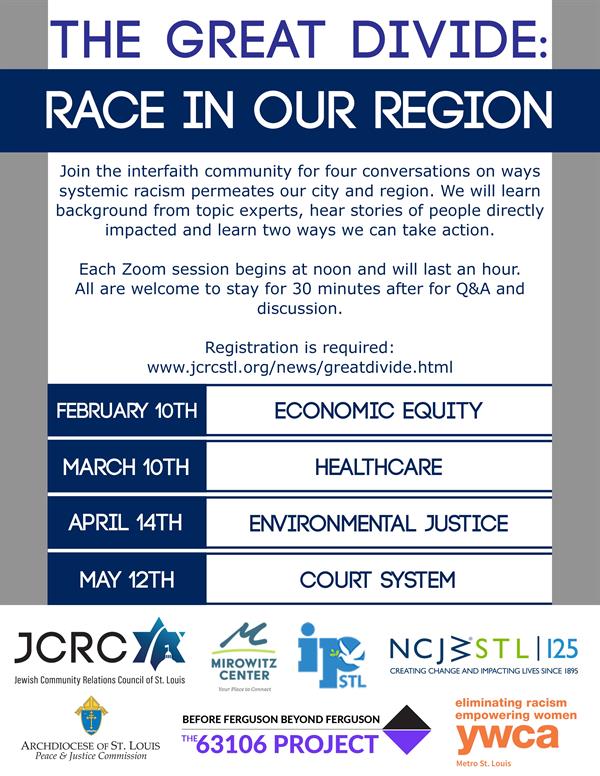St. Louis Neighborhoods Reveal Pandemic's Toll, Need for Change
BY SALLY J. ALTMAN, MPH
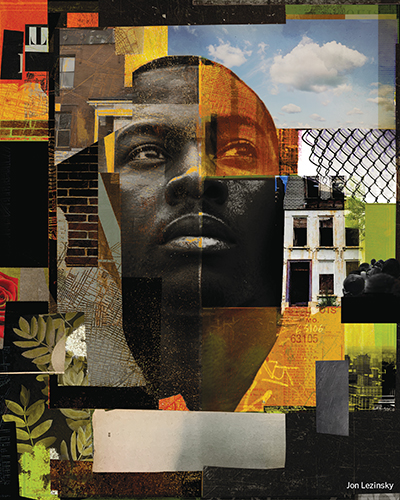
Illustration by Jon Lezinsky
In 2012, everything was finally coming together for Steven Jones. He was in his twenties, making decent money as a grill master at Red Lobster. He was in love and had three daughters with a fourth on the way. Then he suffered through a five-day seizure.
Doctors said Jones had developed a rare form of epilepsy, one of the worst. He went into intense rehab and, as a result, had to miss the birth of his baby girl. As he learned to walk again, the seizures continued, and they ate chunks of his memory. It took years to get the right medication balance to normalize his brain function.
Last year, before COVID-19, he was able to find a slightly better-paying job, driving a scooter around a downtown parking garage picking up trash. But that meant that he would no longer be eligible for Medicaid, food stamps and a monthly disability payment. By the time child support for four daughters was subtracted from his paycheck, he barely had enough to pay rent. Then, in February, he learned of a janitorial opening at the Boeing Learning Center in St. Louis County. It meant a two-hour bus trip each way, but it would pay $18 an hour. He'd just finished the training when the county went into lockdown. Because he had not started work, he was ineligible for unemployment payments.
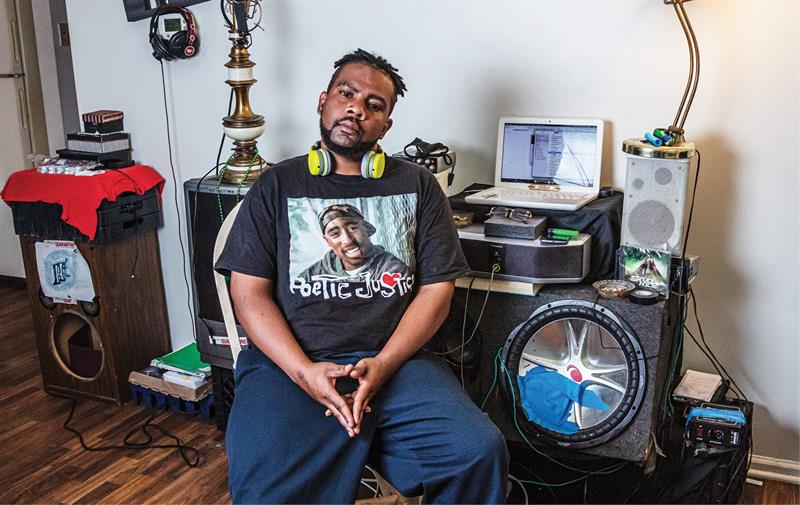
Photo by Matt Marcinkowski
Steven Jones, shown in his Preservation Square apartment near downtown St. Louis, is epileptic and has struggled to find work.
If you are searching for yet another example of how the pandemic falls most heavily on people of color, on those with chronic illnesses, on those living in underserved neighborhoods, Steven Jones is your man. His life and those of others nearby lay bare the health inequities that St. Louis and urban centers around the country must come to grips with as they also try to move on from the pandemic.
For decades, African Americans have suffered from higher rates of chronic diseases, including diabetes and heart ailments that make them more vulnerable. When COVID-19 arrived, it immediately exacted a toll. In June, the St. Louis Post-Dispatch reported that African Americans made up one-third of Missouri's coronavirus deaths, while representing just 12% of the state's population. In St. Louis and St. Louis County, they were dying at nearly double the rate of whites.
Well-resourced families are beginning to see how their fate and future are increasingly tied to families who lack adequate insurance coverage or have none at all. They have been reminded that charges to insured individuals — their deductibles, co-pays and premiums — include the costs of unreimbursed care. They were also learning through news coverage that impoverished and uninsured essential workers might report to work when ill and pass along infections to them or their loved ones.
As happened on the Titanic, citizens region wide — whether in steerage or luxury accommodations — are beginning to recognize they could all could be going down with the ship.
Jones lives in a neighborhood known as Preservation Square, just a mile west of downtown St. Louis in the 63106 zip code. Residents living in 63106 have been identified in a groundbreaking report jointly prepared by Saint Louis University and Washington University as having the most problematic social determinants of health in the region.
A key data point from that report: a child born in 63106 in 2010 had a life expectancy of 67 years. A child's life expectancy increases by almost two decades, to 85, in 63105.
Zip code 63105 covers the municipality of Clayton, the St. Louis County seat, with the white population at about 78% and one of the highest per capita incomes in the region. Zip code 63106 has six times the unemployment rate, almost eight times the poverty rate and less than a quarter of the median income of Clayton. The median income varies greatly, from $15,000 in the St. Louis zip code to $90,000 in the Clayton zip code.
The researchers might have expected that their report would shock the collective conscience of their community. The report was timely, surfacing just a few months before the police shooting of Michael Brown in Ferguson, a municipality located in north St. Louis County. The tragic circumstances drew more attention to the report, which was often cited by the Ferguson Commission that had been formed by then-Gov. Jay Nixon in the wake of the unrest surrounding Brown's death. The commission drafted a report with 189 proposals to address racial equity issues regionwide, including expansion of Medicaid coverage in Missouri.
But Medicaid expansion went unaddressed for six years until this summer.
Perhaps it took a pandemic, a cratering economy and a vivid video showing a Minneapolis police officer kneeling on George Floyd's neck as he sought mercy and cried out to his mama, to create enough empathy for action.
All of that shone "a spotlight in a different way," said Riisa Rawlins-Easley, chief of staff at the St. Louis Regional Health Commission. She noted that previous incidents including the death of Michael Brown awakened concerns among many for marginalized communities, but with the pandemic, "we were at home. You couldn't turn away as easily."
In Missouri, voters went to the polls on Aug. 4, 2020, and approved Medicaid expansion, making the state the 38th in the nation to do so and ensuring that 230,000 more residents would be eligible for coverage. The measure passed with 53% of the vote.
Currently nearly 100,000 people — one in 10 of the total population — are uninsured in metropolitan St. Louis. That will change beginning in July 2021, unless legislative opponents find a way to impede or halt implementation.
The ballot measure certainly got Jones to the polls, although after his new job dissolved, he would have been able to get back on Medicaid anyway.
Still Jones knows that Medicaid alone won't address all the inequities or the health care challenges he faces. And the people active in delivering services to marginalized populations know that's true as well for all the people they have been struggling to serve.
"People who are more into politics than me have said it's going to help people," Jones said.
But Medicaid is perplexing as far as he is concerned. "I couldn't find anywhere where I could read every page and see all the fine lines," he said. "I haven't seen the actual paperwork. As easily as I can find somebody' else's criminal record for $5.99, I should freely be able to look up bills!" (He could have found the ballot measure's text through the Missouri Secretary of State's website, but by now he is used to obstacles and complications. This is unsurprising to public health experts. There's a tendency among many disadvantaged residents to assume the system won't work for them because it hasn't in the past.)
At this point, Jones certainly could use a dentist. His tooth is halfway gone, and the nerve has been exposed for months. "It only hurts at night now," he says, relief in his voice. "That's how I know it's bedtime. After a while, salt doesn't work, and you bite your tongue because the Orajel numbs your mouth." Because of his epilepsy medications, he can't take aspirin.
What Jones didn't know is that Medicaid added adult dental coverage in Missouri in 2016, until a reporter mentioned it to him.
"I just figured you had to have some private insurance," he said. But he isn't enamored with the options. Only two clinics are within a manageable commute and offer dental services for adults using Medicaid, and they are crowded with people seeking health appointments and COVID-19 testing.
Meanwhile, regarding his epilepsy, the Supplemental Security Income program wants records from a general practitioner, not just his neurologist. "I don't have one," he says.
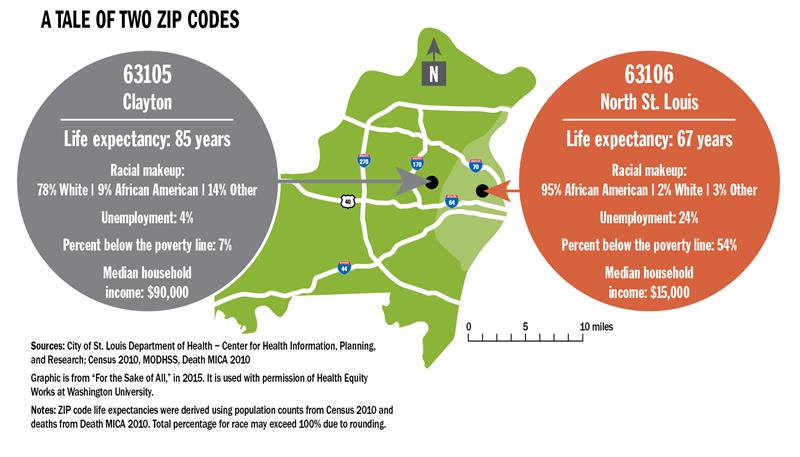
In recent months, Before Ferguson Beyond Ferguson, a nonprofit racial equity storytelling project, has been shining a light on the lives of people in 63106 as they deal with the daily impact of the pandemic. Steven Jones drew the project's attention.
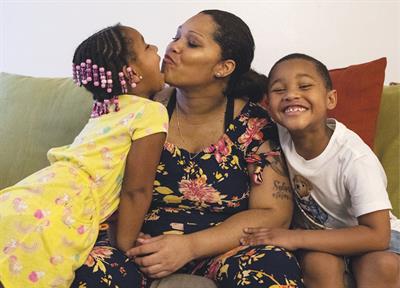
Photo by Colter Peterson/St. Louis Post-Dispatch
Tyra Johnson said her St. Louis neighborhood isn't safe enough for her children Madison, left, and Meegale Hundley, to play outdoors there. by Jon Lezinsky
So did Tyra Johnson, a single mother, with two small children and a newborn. Johnson has had to abandon her dreams of starting online college courses because she is overwhelmed trying to manage her little ones in a small apartment in a neighborhood where it's too dangerous to let her kids even go outside and play. Disciplined and resourceful, she has been keeping her kids' days structured and their learning uninterrupted. But her older two, Meegale, starting first grade and Madison, entering pre-K, are stir-crazy from their isolation and her own life is on hold.
Fortunately Johnson did have access to health care and delivered her newborn without incident. Though she is currently in good health, Johnson is subject to what public health experts call toxic stress owing to her precarious circumstances.
Johnson is terrified that her kids might contract the virus.
"You don't want your kids to go outside and then, you know, they get any type of virus," she said. "It's just like, I can't afford it, you know?"
Even before the pandemic, Johnson would drive her children miles away for a playdate in a park.
"I don't allow them to play around here," she said.
Also living on edge is Kim Daniel, a 54-year-old caregiver, who worries that a long-standing heart ailment makes her easy prey for COVID-19. But she has more to contend with than just that.
Daniel has lived in abject fear ever since the early hours of April 16. That's when a bullet from an automatic weapon slammed into her apartment while she was sewing face masks. Now she dreams of moving to a safer place. But she will need to find a home where she will have easy and frequent access to health care because of a congenital heart defect that has taken her to death's door several times over the course of her life.
Daniel once lived in rural Arkansas and was quite comfortable there. But physicians in Memphis — the nearest big city — told her that St. Louis was her best bet for the specialized medical care she needed. So Daniel returned to her hometown and took the first housing accommodation that became available. She has felt trapped ever since and has begun dreaming again of a rural outpost.
But in other ways such a move makes no sense.
Her son and granddaughter live in Florissant, and her father is in Overland, communities in north St. Louis County. If she were to leave, Daniel said, "I would be sentencing myself to seeing my family even less often than I do now with this pandemic going around."
Moreover, what if Daniel got sick? Could she prevail on a friend or acquaintance to help her?
As chief of staff at the St. Louis Regional Health Commission, Rawlins-Easley is familiar with situations like these that are borne from decades of systemic racism and a health care system tied to employment.
Created in 2002, the commission is a collaborative effort of St. Louis City, St. Louis County, the state of Missouri, health providers and community members to improve the health of uninsured and underinsured citizens in the St. Louis metropolitan region. As the plight of underserved families became ever more acute, the commission in 2012 organized a delivery system called Gateway to Better Health. It has provided up to $25 million annually in funding for primary and specialty care as well as other outpatient services. The Gateway to Better Health program has provided coverage to nearly 64,000 uninsured and under-insured adults. (Rawlins-Easley noted that SSM Health and Mercy Hospital St. Louis participate as in-network locations for Gateway.)
"When we think about our work, we often talk about the dual pandemic of racism and COVID-19 that we're grappling with right now," Rawlins-Easley said. "Institutionalized racism is baked into our system. We have rates of fetal and maternal mortality that are akin to third world countries. Black women are four times more likely to die in post-pregnancy than white women, and babies are at least three times more likely to die before their first birthday."
Along with all that, Rawlins-Easley adds, is the mistrust and uncertainty many African Americans bring with them when they interact with health care systems. These doubts date back generations to times when some communities across the nation simply refused to provide care for people of color at their local hospitals and infamously to a time when U.S. Public Health researchers over several decades in the middle of the 20th century charted the course of syphilis in 600 black men. Officials involved with the Tuskegee Experiment in most cases never told the men they had the disease, and, in some cases, denied them treatment. The study, once it was exposed in the 1970s, led to distrust for the medical system so great that it affected the life spans of black men for generations to come.
The distrust endures.
Courtnesha Rogers, another 63106 resident with small children, is already thinking about the prospect of a COVID-19 vaccine. "If my kids are required to get vaccinated, I'm gonna homeschool them," she said.
Kim Daniel is wary as well: "I am not at all willing to accept a vaccine, at least not in its beginning stages. It takes time to know the stability of a drug or vaccine, and its effects on populations. However, once the vaccine has been in usage for a decent span of time and science learns there are no negative impacts of the vaccine or adverse effects, then I will consider the option. My hope is legislators will not pass legislation, forcing the skeptical to accept a vaccine against their volition." Under the circumstances, that sounds absolutely prudent on Daniel's part.
Rawlins-Easley says that her organization, along with facilitating direct services and bringing COVID-19 testing to urban neighborhoods, has developed a communications strategy. "We recognized a lot of communication going on was confusing and contradictory and not a lot of it was targeted specifically to underrepresented communities," Rawlins-Easley said. "So we quickly pulled together a communications strategy to dispel myths that existed. We partnered with Black-run organizations that already had established relationships."
The result: A portal called PrepareSTL, a site for all things related to COVID-19, including a straightforward down-to-earth video providing useful guidance on how to deal with the pandemic.
PrepareSTL features a video from Rebeccah Bennett, founder of the InPower Institute, an organization that focuses on community healing. In it she addresses the distrust that Black residents feel toward government, the health care system and the media.
"Many of us are on the streets where we don't have protective gear on... because we don't actually believe what we are hearing," Bennett says. "We don't trust the institutions that are giving us this information. Many of us don't trust our health care systems … We haven't been treated with care and professionalism. There are those of us who don't trust the media … What you need to know is we are out here dying. We aren't just dying later. We are dying first. It is incumbent on us to take this thing seriously. Why? Because our Black lives matter. So what is it that you need to know to stay as safe as possible …"
This is common sense information a guy like Steven Jones can use.
"I just got informed that us as Black men, we don't have regular doctors and that's why we are leading in all these diseases," Jones said. "Well, who tells us we need to go? We didn't learn that in health class, that we needed to go to the doctor even if something wasn't wrong with us. If y'all let me know these things, I will do these things."
This article includes additional reporting from JEANNETTE COOPERMAN, AISHA SULTAN and RICHARD H. WEISS
SALLY J. ALTMAN has devoted her career in public health to working with key stakeholders on health access issues as a health care administrator and a journalist. JEANNETTE COOPERMAN is a St. Louis journalist and an essayist for Washington University's The Common Reader. AISHA SULTAN is a nationally syndicated newspaper columnist, award-winning filmmaker and features writer. RICHARD H. WEISS is founder and executive editor of Before Ferguson Beyond Ferguson, a non-profit racial equity storytelling project.
RELATED RESOURCES
Before Ferguson Beyond Ferguson project: https://beforefergusonbeyondferguson.org/.
"Sick Alone, Mourning Alone: COVID-19 Hits the Elderly and African Americans the Hardest," St. Louis Post-Dispatch, June 8, 2020, https://www.stltoday.com/business/local/sick-alone-mourning-alone-covid-19-hits-the-elderly-and-african-americans-the-hardest-in/article_bab7f387-0667-51d6-b29f-4c0660b3e017.html.
"Clayton Conundrum: St. Louis County Seat Tackles Race Relations, St. Louis Post-Dispatch, March 8, 2020, https://www.stltoday.com/news/local/metro/clayton-conundrum-st-louis-county-seat-tackles-race-relations/article_49d560cd-6ff8-5d17-99c9-05ea3a5c8e52.html.
PrepareSTL: https://www.preparestl.com/, and PrepareSTLvideo: https://www.youtube.com/watch?v=e5Juom06_XU&feature=youtu.be.

Before Ferguson Beyond Ferguson, a nonprofit racial equity storytelling project, has been shining a light on the lives of people in the 63106 zip code as they deal with the daily impact of the pandemic.
The neighborhoods within that zip code lie just west of downtown St. Louis. Nearly 12,000 people — about 95% of them African American—live in the area's slightly more than two square miles. In 2014, a study by social scientists at Washington University and Saint Louis University reported that the zip code's social determinants of health — factors such as education, employment and income levels as well as access to medical care, crime, and housing — were the most problematic in the region. Under the guidance of the nonprofit, Before Ferguson Beyond Ferguson, St. Louis media outlets that normally compete with one another agreed to collaborate and carry stories in serial fashion — a new "episode" approximately every six to eight weeks. So far six families have been covered with one or more installments; reporting and research is underway for two more families. Notably, none of the people in these stories turned out for the protest demonstrations in the wake of the police killing of George Floyd and the inequities laid bare over the course of the pandemic. These families say they are almost entirely sympathetic to the Black Lives Matter movement, but they have so much on their plates that it's nearly impossible for them to participate. They are truly among the unheard and these stories give them a voice. The stories can be found at https://beforefergusonbeyondferguson.org/63106-project/ |
Want to learn more about the work of Before Ferguson Beyond Ferguson featured in Health Progress and hear updates from some of those featured in this story? Reporters and those they interviewed will take part in a series of online discussions about systemic racism. They're open to the public but require advanced registration.
